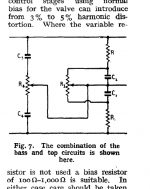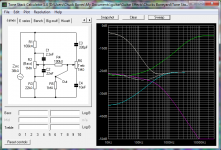Chuck D. Bones
Circuit Wizard
First thing, here's a great resource on tone controls that I stumbled across after writing Part 1:
https://www.guitarscanada.com/attachments/10-tone-control-pdf.352944/
It contains the same info I'm presenting in these articles and then some.
James
E. J. James published the tone control circuit bearing his name in the February 1949 issue of the British magazine Wireless World.
It is a passive filter that introduces about 20dB of insertion loss when the BASS & TREBLE controls are centered. Originally designed for hi-fi use, it was adopted by guitar amplifier manufacturers Ampeg (left) and Orange (right).
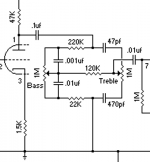
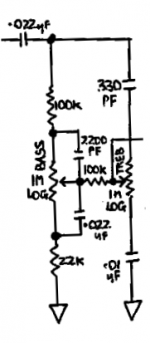
The pots are usually audio taper to provide a uniform sweep. In the Ampeg design, the component values are proportioned to provide a flat freq response when the BASS & TREBLE controls are at noon. TSC shows that the Ampeg tuning sets the bass / treble crossover at around 1KHz, a little high for guitar amp & pedal use IMO.

The Orange circuit is tuned lower and less symmetrically.
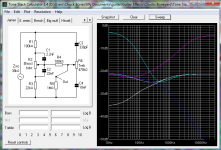
The James tone stack really does not need a MID control because a mid notch is obtained by setting BASS & TREBLE above noon while a mid hump is obtained by setting BASS & TREBLE below noon. R4 can be tweaked to move the freq of the mid notch / hump. In fact, R4 could be replaced with a B500K pot in series with a 47K resistor.
The James tone stack shows up in the Viceroy pedal (below), tuned similarly to the Orange tone stack. It also appears in the PCBGuitarMania Acapulco Tone and the various Revv G pedals.
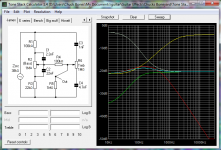
The advantages of the James tone stack are large BASS & TREBLE sweeps, tweakability, minimal interaction between the controls and the ability to set the freq response to flat. The disadvantages are the relatively high component count (compared to the Fender tone stack) and insertion loss.
Baxandall
Peter J. Baxandall published the tone control circuit bearing his name in the October 1952 issue of Wireless World. The Baxandall tone stack is classified as an active filter because it requires a gain element to function. In the Wireless World schematic below, the vacuum tube serves at the gain element.
Note that Baxandall used a tapped pot for the TREBLE control. The tap is actually not necessary as long as a DC path is provided from the grid to ground. With opamps or transistors, a DC path to the appropriate bias voltage is required. Usually, there are series resistors at both ends of the TREBLE control to limit boost and cut to reasonable levels. There is an alternate version of the treble control that replaces C3 with a resistor and puts series caps at either end of the TREBLE control (see the Acid Rain tone stack below). Sometimes the two bass capacitors are merged into one. The circuit does not need to be balanced. The caps or resistors can be deliberately unbalanced if you want more cut than boost, or if you want the cut and boost to kick in at different frequencies.
The advantages of this circuit are large BASS & TREBLE sweeps, minimal interaction between the controls, tweakability, the ability to set the freq response to flat and zero insertion loss. The disadvantages are large parts count and the need for a gain element: either an opamp, transistor or vacuum tube. TSC does not support the Baxandall tone stack; if you need to simulate it, you'll have to use an engineering tool such as LTSpice.
https://www.guitarscanada.com/attachments/10-tone-control-pdf.352944/
It contains the same info I'm presenting in these articles and then some.
James
E. J. James published the tone control circuit bearing his name in the February 1949 issue of the British magazine Wireless World.
It is a passive filter that introduces about 20dB of insertion loss when the BASS & TREBLE controls are centered. Originally designed for hi-fi use, it was adopted by guitar amplifier manufacturers Ampeg (left) and Orange (right).


The pots are usually audio taper to provide a uniform sweep. In the Ampeg design, the component values are proportioned to provide a flat freq response when the BASS & TREBLE controls are at noon. TSC shows that the Ampeg tuning sets the bass / treble crossover at around 1KHz, a little high for guitar amp & pedal use IMO.

The Orange circuit is tuned lower and less symmetrically.

The James tone stack really does not need a MID control because a mid notch is obtained by setting BASS & TREBLE above noon while a mid hump is obtained by setting BASS & TREBLE below noon. R4 can be tweaked to move the freq of the mid notch / hump. In fact, R4 could be replaced with a B500K pot in series with a 47K resistor.
The James tone stack shows up in the Viceroy pedal (below), tuned similarly to the Orange tone stack. It also appears in the PCBGuitarMania Acapulco Tone and the various Revv G pedals.

The advantages of the James tone stack are large BASS & TREBLE sweeps, tweakability, minimal interaction between the controls and the ability to set the freq response to flat. The disadvantages are the relatively high component count (compared to the Fender tone stack) and insertion loss.
Baxandall
Peter J. Baxandall published the tone control circuit bearing his name in the October 1952 issue of Wireless World. The Baxandall tone stack is classified as an active filter because it requires a gain element to function. In the Wireless World schematic below, the vacuum tube serves at the gain element.
Note that Baxandall used a tapped pot for the TREBLE control. The tap is actually not necessary as long as a DC path is provided from the grid to ground. With opamps or transistors, a DC path to the appropriate bias voltage is required. Usually, there are series resistors at both ends of the TREBLE control to limit boost and cut to reasonable levels. There is an alternate version of the treble control that replaces C3 with a resistor and puts series caps at either end of the TREBLE control (see the Acid Rain tone stack below). Sometimes the two bass capacitors are merged into one. The circuit does not need to be balanced. The caps or resistors can be deliberately unbalanced if you want more cut than boost, or if you want the cut and boost to kick in at different frequencies.
The Baxandall tone stack shows up in several guitar pedals: Colorsound Overdriver, PedalPCB Acid Rain, Thorpy Fallout Cloud & M.I. Audio Super Crunch Box. The EQD Talons & JHS Charlie Brown have a Baxandall stack with an additional MID control crammed in. The added MID control is hard to execute properly. JHS got it right and EQD failed miserably. M.I. Audio added the MID control as a separate stage for the ultimate in control isolation. The treble portion of a Baxandall tone stack shows up in the Klon. In the Acid Rain Baxandall tone stack below, Q4 provides the gain element.The advantages of this circuit are large BASS & TREBLE sweeps, minimal interaction between the controls, tweakability, the ability to set the freq response to flat and zero insertion loss. The disadvantages are large parts count and the need for a gain element: either an opamp, transistor or vacuum tube. TSC does not support the Baxandall tone stack; if you need to simulate it, you'll have to use an engineering tool such as LTSpice.
Attachments
Last edited:


